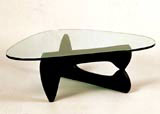Bright ideas
The Design Museum hosts an exhibition to celebrate the life and works of Japanese artist and designer Isamu Noguchi. Miriam Cadji enlightens us

The phrase “East meets West” generally conjures up ghastly images of the crass fusion of cultures, such as roast beef with sun-dried lemon grass. But visitors to the latest exhibition at the Design Museum can take heart – this time its use is somewhat more meaningful.
Opening this month, the exhibition is devoted to the work of artist and designer Isamu Noguchi, born in 1904 to a Japanese father and American mother. Influenced by both traditional Japanese crafts and American modernism, Noguchi crossed cultural and geographic boundaries and his work slipped between disciplines seamlessly. Without undermining his standing as an artist, he was a respected industrial designer, set designer and landscape architect, gaining both critical acclaim and commercial success in his lifetime. Noguchi did not recognise any conflicts between these worlds. Instead, he saw only connections. For him, designing for the theatre was to deal with spatial concerns, while his industrial designs of the 1940s were an extension of his interest in sculptural form. “Everything is sculpture. Any material, any idea without hindrance born into space, I consider sculpture” he said.
Throughout his prolific career his collaborations were characteristically diverse: he worked with such influential figures as architect and mathematician Buckminster Fuller, sculptor Constantin Brancusi, poet Ezra Pound and choreographers Martha Graham and Merce Cunningham. Despite developing furniture for big names such as Herman Miller and Knoll, he is best remembered for the simple Akari mulberry bark and bamboo light sculptures he designed in the 1950s and 1960s for the Japanese city of Gifu. Now synonymous with humble bedsits and student digs, the paper lantern arguably owes its widespread appeal to Noguchi.
Despite this, his name is little known in the UK, and this is the first opportunity to view his work en masse outside North America. This show continues the Design Museum’s special relationship with the Vitra Design Museum – which has led to such blockbusters as the recent Charles and Ray Eames show and the outgoing Luis Barragáextravaganza – although Noguchi is less of an obvious crowd-pleaser. It is a happy coincidence that this will be the museum’s new director Alice Rawsthorn’s inaugural exhibition. She is a self-confessed fan of Noguchi’s work and has enlisted the help of avant-garde American theatre designer Robert Wilson, who is responsible for the look of the show.
Rather than being laid out as a chronological story of the sculptor’s life, Wilson is treating the exhibition as a series of installations. Having designed sets for dance and stage productions (also working with choreographers Cunningham and Graham), Wilson has moved in the same milieu as Noguchi, and promises to deliver a sympathetic setting in harmony with the subtle work displayed. The gardens that Noguchi designed towards the end of his life will be evoked in the upper galleries, a decision that posed the logistical nightmare of getting nine tons of sand up to the second floor. Wilson insisted on Cornish sand, and samples were sent back and forth to New York (Wilson’s base) and Germany (Vitra’s headquarters), to ensure they were exactly right. Sand aside, Noguchi’s archive photos, original models, sculptures and furniture will no doubt shine through.
Isamu Noguchi, from 20 July until 18 November, at the Design Museum, Shad Thames, London SE1
-
Post a comment




